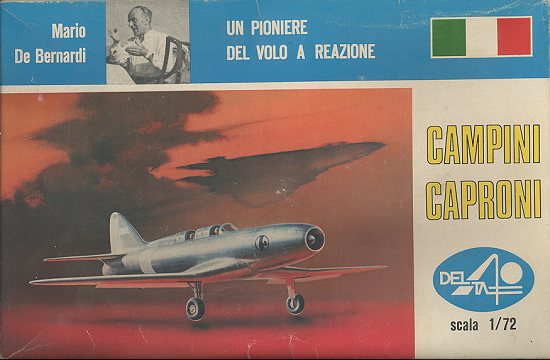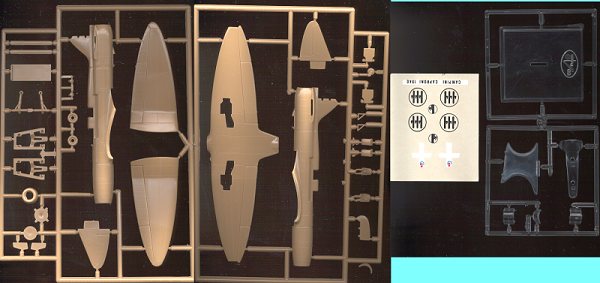
|
KIT: |
Delta 1/72 Campini Caproni |
|
KIT # |
|
|
PRICE: |
Currently $15.98 |
|
DECALS: |
The prototype |
|
REVIEW & |
|
|
NOTES: |

|
HISTORY |
When one thinks of early jets, Italian jets are not what comes to mind. However, the Italians did successfully fly a jet aircraft of sorts on 30 April 1940, less than a year after the first turbojet, the He-178. What makes the Campini Caproni unique is that it used a ducted fan with a sort of afterburner. The compressor section was driven by a 900hp Isotta Franchini piston engine. This produced compressed cold air. Unlike a turbo jet, there was no hot compressor section. This cold compressed air was ducted into the rear of the jet pipe and there it was mixed with fuel and ignited, providing additional thrust. This type of engine is often referred to as a ducted fan, however since the exhaust is mixed with fuel and ignited, it is a true jet engine.
On the cold thrust alone, the Campini Caproni was capable of
speeds over 200 kph, however with the addition of the 'afterburner', speeds
easily doubled to 400kph. The total performance of the aircraft was stifled by
an inability to fly higher than about 4,000 meters due to the power dropoff of
the piston engine. Had additional time and effort been put into this project
using a supercharged piston engine of higher power, greater speeds at higher
altitudes would have been possible. However the war situation and the need to
concentrate on operational aircraft ended the career of the Campini Caproni.
This historic aircraft is still extant and in the *Aeronautica Militare Museo Storico di Vigna di Valle* (the Italian
Air Force Museum) just outside of Rome. (Thanks to Tim Kalina for that
information.)

|
THE KIT |
There is only one kit of the Campini Caproni generally available and that is from Delta. This kit has been around nearly 30 years and is pretty much what you'd expect from a kit of the early 70s. The plastic is thick and in a brown plastic. All panel lines are raised and there are rivets 'enhancing' all the panel lines and control surface 'detail'. Clear bits are thick and not very transparent, though the plastic in the stand is nice and clear. Speaking of which, the stand is very nice and includes a 'saddle' for you to rest your completed kit upon, though there are no directions for assembling the stand.
There are no real wheel wells and it appears that this kit has retractable landing gear as the gear door mounts are VERY thick. Interior consists of a floor, two seats and two crew figures, however you can't see much through the thick transparencies so no loss here. The canopies are designed to be able to slide back and forth, but I'd recommend leaving them closed. The rudder is separate from the rest of the fuselage. Design of the intake and exhaust is such that there will be no 'see through' effect.
The instruction sheet is a pictogram affair with a parts breakdown and 5 step construction sequence. The painting guide is on the back sheet and is similar to Matchbox's guide showing what parts are what color. One will basically be using metallics on this one as well as white. The decals are quite basic being just insignia and a name plate. They don't look very good, but my example is quite ancient. I'll be looking to replace them if possible. There are two paint schemes, one with a red intake and one without. The rest of the aircraft is natural metal.
Included with the kit is a nice little booklet outlining the history of the aircraft, the propulsion system and the pilot. This alone probably makes the kit worth getting as it is quite informative and shows a number of photographs of the real aircraft. Judging by the 1973 date on the booklet, that would pretty well determine when the kit was made! It is interesting to note that the cloud above the aircraft on the box top looks quite similar to the Tornado, then just undergoing trials.
Review copy courtesy of me and my wallet!
If you would like your product reviewed fairly and quickly by a site that has over 800 visits a day, please contact me or see other details in the Note to Contributors.